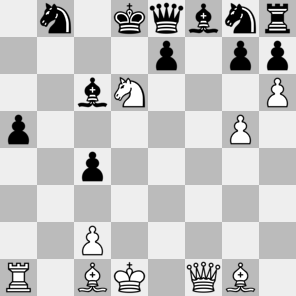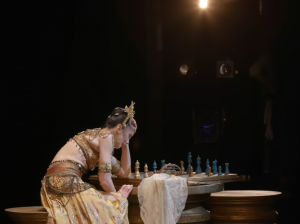I am really treading on unfamiliar grounds with this one, so bear with me. La Bayadère (the temple dancer) is a ballet with music by Ludwig Minkus, first performed in 1877 with choreography by Marius Petipa.1 Then, it was pretty much forgotten for a few decades, until it performed with great success by the Kirov ballet in the Soviet Union. There, it quickly grew into a classic, but it had to wait for a western revival until the early sixties. So far, so simple. But — and apparently this is normal in ballet — the original choreography had been changed several times, with pieces being deleted, redone, or moved as was seen fit. I give you all this information as a fair warning: do not watch La Bayadère expecting a chess board, for it might not appear. Of course, we are talking about a version of the ballet which does include a chess board: the recent Royal Ballet performance in a production by Natalia Makarova.
Let me first quickly recall the plot, insofar as a ballet ever has such thing. The action is set in what a nineteenth century European might have thought was medieval India. The eponymous temple dancer is called Nikiya. She and the mighty warrior Solor have promised each other eternal love (because of course they have), but some high priest-like figure also has his eyes set on her. Things are further complicated (because of course they are) by the fact that the local Rajah wants Solor to marry his daughter Gamzatti (because of course he does) who is also strongly in favour of this idea.
Obviously, these are not ideal circumstances conducive to a happy and peaceful coexistence off all parties involved, as is further corroborated by the picture above. Nevertheless, I want to talk about this screenshot for, mourning woman aside, there are some interesting things about it. Here’s my reconstruction:2
 but it is very tentative. Unfortunately, the cameramen seem to have been sadly distracted by all the dancing and they did not focus very well on the board. It is, however, very clear — surprise, surprise! — that the board has been set up wrongly once again: h8 is a white square, and the kings and queens have swapped places.
but it is very tentative. Unfortunately, the cameramen seem to have been sadly distracted by all the dancing and they did not focus very well on the board. It is, however, very clear — surprise, surprise! — that the board has been set up wrongly once again: h8 is a white square, and the kings and queens have swapped places.
Everything on the queenside is little more than invention, but I’m pretty sure about the kingside – and it makes no sense at all. How on earth did white’s pawns manage to push all the way to the fifth and sixth rank while the black pieces are still undeveloped? With the exception of the insolent knight on d6, the white pieces, too, are all on the back rank. Which leaves us to wonder: what happened with all the pawns? Who took them? Why did he go back?
The explanation is simple: they only come out when the corps de ballet is on stage.
Realism: 1/5 Extra points subtracted for the terrible set-up of the board and there being two black-squared white bishops. (Well, white-squared, as the board is set up wrongly! Bah Humbug!)
Probable winner: That’s easy: whosever move it is. If it’s black he can take the knight on d6, if it’s white he can take the queen on e8.
1. [With a name like that, you have no choice but to become a choreographer.]↩
2. [In original choreography by petitcase.]↩
